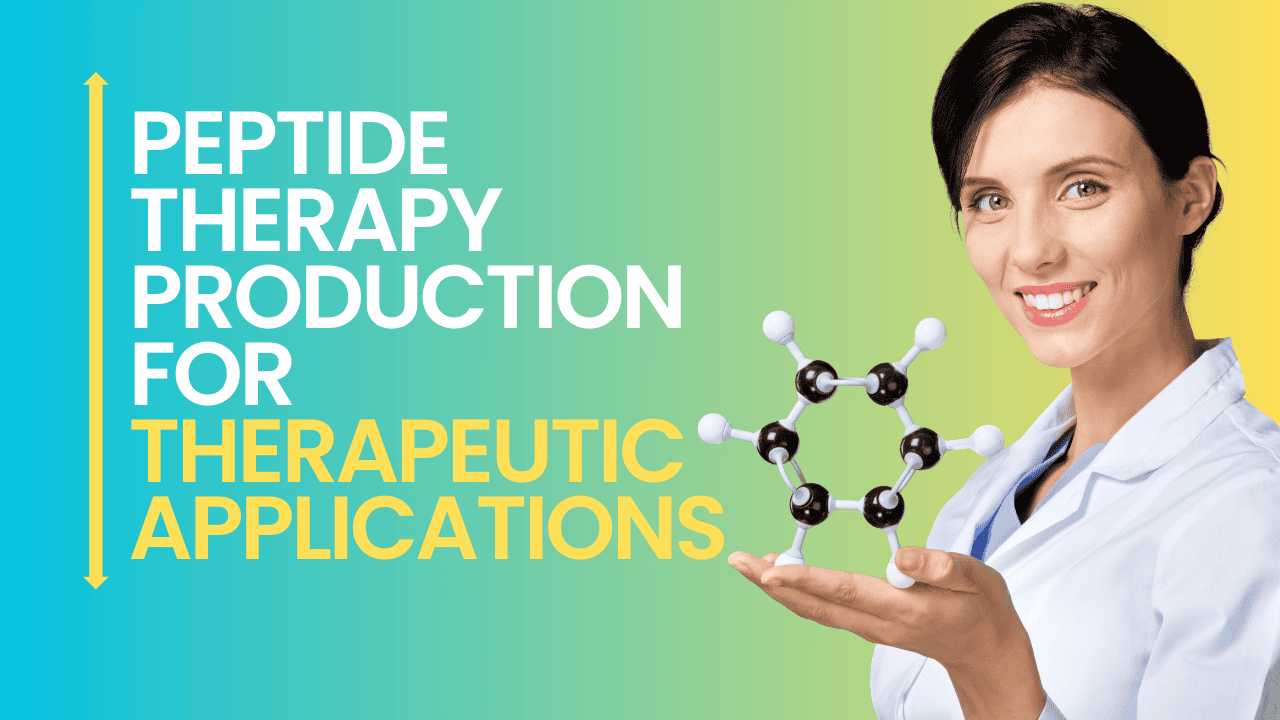

_Producing peptides and proteins isn’t just a scholarly pursuit—it’s the lifeblood of modern medicine, research, and biotechnology.
Understanding how peptides are synthesized, the intricate methods involved, and the importance to our daily lives, this guide dives deep into all aspects of peptide and protein production.
Whether you’re a seasoned researcher or a curious novice, this article provides a comprehensive, relatable, and engaging look at what makes the peptide and protein world turn.
Peptide and protein production refers to the methods and processes used to synthesize these vital biomolecules. These processes are crucial in various fields, from pharmaceuticals to nutritional supplements. But let’s not get too caught up in the jargon—essentially, it’s about creating building blocks of life.
Solid-phase peptide synthesis (SPPS) is the rock star here. This method anchors the growing peptide chain on a solid support, facilitating easier purification. You can think of it like building a Lego set – only each block is an amino acid.
Chemical synthesis offers the flexibility to create complex peptide sequences that can be too tricky for biological methods. Imagine crafting a custom suit; chemical synthesis offers that precision and customization.
Protein synthesis involves assembling long chains of amino acids, whereas peptide synthesis usually handles shorter peptides. Think of proteins as a novel and peptides as short stories—they both tell a narrative but differ in length and complexity.
Protein synthesis steps include initiation, elongation, and termination, akin to starting a car, driving, and then parking it. Each stage is meticulously regulated to ensure the final protein form is accurate and functional.
Peptide manufacturing involves multiple stages, from synthesis to purification. It’s like cooking a gourmet meal; every ingredient and step matters. The goal is to achieve high peptide purity and consistency.
Custom peptide manufacturing tailors peptides to specific needs, much like ordering a bespoke suit. The process starts by defining the peptide sequence and follows through synthesis to final peptide formulation.
Solid-phase synthesis is a game-changer in peptide production. It ties each amino acid step-by-step to a solid resin, making the whole shebang more manageable. Imagine threading beads onto a string—each bead is an amino acid, making up your growing peptide chain.
Peptide synthesis involves attaching amino acids in a specific sequence. Utilizing peptide coupling agents is crucial here. It’s like assembling a precise jigsaw puzzle where each piece must fit perfectly to form a protected peptide.
Cyclic peptides are fascinating—they form a ring structure, providing stability and unique functionalities. Think of them as necklace loops—robust and durable yet highly functional.
Researchers use custom peptides to explore protein functions, develop peptide drugs, and even study disease mechanisms. Custom peptides are the Swiss Army knives of biological research.
Custom peptide synthesis allows for flexibility, precision, and tailored solutions to unique scientific problems. It’s research with a personal touch.
SPPS starts with anchoring the first amino acid to a solid support, followed by sequential addition of protected amino acids. This method helps create longer peptide sequences efficiently.
SPPS is highly efficient, especially for long peptide sequences. It maximizes yield and purity, making it the go-to method for many applications.
Chemical synthesis utilizes reagents and catalysts to form peptide bonds. This process is controlled and precise, ideal for producing synthetic peptides.
Chemical synthesis offers control, customization, and ability to handle complex peptide sequences that might be infeasible through biological methods.
The peptide manufactu
ring process involves synthesis, purification, and characterization. It’s a meticulously orchestrated pathway to ensure that the peptide product meets stringent quality standards.
Key challenges include achieving high purity, managing peptide chain assembly, and ensuring good manufacturing practice standards. These hurdles demand expertise and innovation.
Synthetic peptides are lab-crafted sequences designed for specific applications, from research tools to therapeutic agents. They are made to measure, like fine haute couture.
Synthetic peptides are pivotal in studies of protein functions, drug development, and diagnostics. They act as models and tools to unravel biological complexities.
Peptides are shorter chains of amino acids, while proteins are longer, folded structures. Essentially, peptides are the building blocks that, when connected, form proteins.
The key differences lie in their size, complexity, and function. Proteins fold into intricate shapes, serving diverse biological roles, whereas peptides often act as signaling molecules or therapeutic agents.
Long peptides typically consist of 50 or more amino acids. Synthesizing long peptide sequences demands advanced techniques to maintain sequence accuracy and structural integrity.
Synthesis of long peptides involves more steps, stringent conditions, and higher chances of errors. It’s like building a skyscraper versus a single-story house—both require expertise, but the complexity scales up.
Best practices include meticulous planning of the peptide sequence, using high-quality reagents, and optimizing reaction conditions. Efficiency is key in achieving desired peptide results swiftly.
Optimization involves refining each step from sequence design to purification, ensuring maximum yield, purity, and cost-effectiveness in peptide production.
Customization is crucial as it allows tailoring peptides to specific research or therapeutic needs. Customized peptides drive innovation and discovery.
Custom peptide manufacturing begins with designing the peptide sequence, followed by synthesis, purification, and rigorous quality checks to ensure the peptide meets the desired specifications.
Cyclic peptides have enhanced stability and bioactivity due to their ring structure. They resist degradation, making them valuable in drug design and research.
Cyclic peptides are synthesized through chemical reactions that form a covalent bond between the peptide ends, creating a stable ring structure.
Recent advancements include innovative methods like cell-free protein synthesis and enhanced expression systems, expanding the horizons of protein engineering and protein and peptide drugs development.
New technologies streamline the manufacturing process, increasing the efficiency and scalability of peptide and protein production, enabling quicker and more reliable outputs.
Methods include solid-phase synthesis, solution-phase synthesis, and chemical synthesis. Each offers unique advantages depending on the peptide complexity and desired application.
Common pitfalls include incomplete reactions, peptide chain aggregation, and purification challenges. These can be avoided by optimizing reaction conditions and using state-of-the-art purification techniques.
Traditional methods involve liquid phase peptide synthesis and solid-phase synthesis. These techniques provide the foundation upon which modern peptide synthesis techniques are built.
Modern techniques like automated synthesizers and enhanced coupling reagents have made peptide synthesis more efficient, scalable, and reliable, driving advances in therapeutic peptide development.
Proteins and peptides play pivotal roles in biological systems, acting as enzymes, hormones, and structural components. Their functions are vast and vital.
Applications range from drug development to biomarker discovery, therapeutic interventions, and fundamental biological research. Proteins and peptides are key in unlocking biological mysteries.
Chemical synthesis is crucial for large-scale production, offering precision, reproducibility, and scalability needed for industrial peptide applications.
Innovations include green chemistry approaches, novel coupling agents, and automated synthesis technologies, enhancing the efficiency and environmental friendliness of peptide production.
Synthesis is the backbone of peptide manufacturing, dictating the quality and consistency of the final peptide products used in various applications.
The manufacturing process adapts by optimizing synthesis protocols, purification stages, and analytical techniques for peptides of varying lengths and complexities.
Researchers require custom peptides for specific experimental needs, such as studying protein interactions, developing assays, or testing new therapeutic targets.
Custom peptides are tailored by designing specific sequences, modifying side chains, and incorporating protective groups to achieve desired structural and functional outcomes.
Cutting-edge techniques include high-throughput synthesis, real-time monitoring of synthesis reactions, and advanced purification methods like high-performance liquid chromatography.
Quality and consistency are maintained through stringent process control, rigorous testing, and adherence to current good manufacturing practice standards.
Chemical synthesis offers greater control and customization, while biological methods can be more cost-effective for large-scale production. Each has its niche depending on the application needs.
Advantages of chemical synthesis include precision and flexibility, whereas biological methods benefit from scalability and potentially lower costs. The choice depends on the specific requirements of the peptide project.
The future is bright, with ongoing advancements aimed at improving efficiency, reducing costs, and expanding the applications of peptides and proteins in medicine and beyond.
Advancements will drive innovation, leading to new therapeutic peptides, improved research tools, and a deeper understanding of biological processes, ultimately benefiting healthcare and science.
Main challenges include handling complex sequences, optimizing reaction conditions, and achieving high purity and yield in the peptide synthesis process.
These challenges can be overcome by leveraging advanced synthesis technologies, fine-tuning reaction protocols, and using high-purity reagents to ensure optimal peptide production.
The world of peptide and protein production is ever-evolving, driving forward our understanding and capabilities in science and medicine. Your journey into this fascinating field begins here!
Yes, a peptide project can be an exciting endeavor in research or pharmaceuticals. You can develop custom peptides tailored to specific needs, leveraging solid phase peptide synthesis and other modern methods. This approach ensures precision in the synthesis of the peptide sequence. For more details, explore the benefits of custom peptide synthesis.
A peptide is synthesized typically through solid phase peptide synthesis (SPPS). This method involves anchoring the first amino acid to a solid resin, then sequentially adding protected amino acids. Each step includes peptide bond formation processes to build the desired peptide sequence. Following the synthesis, the peptide undergoes a purification process to achieve high purity.
Bachem is renowned for its comprehensive services in peptide manufacturing, including large-scale peptide APIs production. They offer expertise in peptide synthesis, including fmoc solid phase peptide synthesis and chemical peptide synthesis. For further exploration, you can visit their website and delve into their extensive portfolio and custom synthesis capabilities.
Peptides are crafted through the meticulous method of peptide synthesis via solid phase or solution phase synthesis. Solid phase peptide synthesis (SPPS) remains the preferred technique for high fidelity and efficiency, allowing for the sequential addition of amino acids. This method is paramount in the manufacture of peptides for research and therapeutic applications.
Peptides are made by assembling amino acids in a defined sequence through SPPS or solution-phase peptide synthesis. The process involves coupling each amino acid with the growing peptide chain, employing precise conditions to ensure effective peptide bond formation. The procedure concludes with a purification process to obtain the final peptide with high purity.
Peptides are synthesized using either solid phase synthesis or solution-phase synthesis. Solid phase peptide synthesis (SPPS) uses a resin-bound amino acid to facilitate step-by-step addition, ensuring controlled peptide bond formation. This method aids in generating peptides for various applications, including peptide therapeutics and research.
Peptide synthesis involves the sequential assembly of amino acids using SPPS. Each building block is added to a solid support, ensuring efficient peptide bond formation. This technique simplifies the synthesis process, allowing for the creation of complex peptide sequences with high accuracy and purity.
Peptides are created through a series of chemical reactions known as peptide synthesis. Solid phase peptide synthesis (SPPS) is commonly used, where amino acids are added step-by-step to a solid resin. This method ensures high fidelity in the peptide bond formation process and is essential for peptide chemistry and drug development.
Peptide synthesis is performed using techniques like SPPS or solution-phase peptide synthesis. These methods involve the addition of amino acids to form peptide bonds, resulting in a peptide sequence. The synthesis of peptides and proteins in this manner is essential for creating biologically active peptides used in therapeutic and research settings.
Peptides are synthesized through solid phase peptide synthesis (SPPS) or solution-phase synthesis. These processes involve coupling amino acids to form peptide bonds, building a desired peptide sequence. Advanced techniques in peptide chemistry and synthesis enhance the efficiency and scalability of peptide production for various scientific and medicinal applications.
Dr. Richard DiMarchi is a preeminent scientist in the field of peptide therapeutics, focusing on the design and synthesis of biologically active peptides for pharmaceutical applications. With over three decades of experience, Dr. DiMarchi has been at the forefront of peptide and protein drug discovery, particularly in the areas of diabetes, obesity, and endocrine disorders.
Dr. DiMarchi’s notable publications include:
Dr. DiMarchi’s work is renowned for its innovative approaches and profound impact on therapeutic developments. He has received numerous accolades, including the 2011 Erwin Schrödinger Prize, which underscores his authority and trustworthiness in peptide research. His contributions continue to shape the landscape of peptide therapeutics, enhancing both industry and academic research.
Dr. Christian Heinis is a leading researcher in the field of peptide drug development, known for his pioneering work in the synthesis and optimization of cyclic peptides. With a robust background in peptide chemistry, Dr. Heinis has significantly advanced our understanding of how cyclic peptides can be designed for enhanced stability and bioactivity.
Key publications by Dr. Heinis include:
Dr. Heinis’s research is characterized by its meticulous methodology and groundbreaking discoveries. His work has earned him accolades such as the Philip Morris Research Prize, reinforcing his expertise and reliability in the field of peptide drug development. Through his extensive research and numerous collaborations, Dr. Heinis continues to drive forward the scientific understanding and application of peptides in medicine.
Chng, J., Wang, T., Nian, R., Lau, A., Hoi, K. M., Ho, S. C., Gagnon, P., Bi, X., & Yang, Y. (2015). Cleavage efficient 2A peptides for high level monoclonal antibody expression in CHO cells. mAbs, 7(2), 403–412. https://doi.org/10.1080/19420862.2015.1008351
Day, K., Prodromou, R., Bosari, S. S., Lavoie, A., Omary, M., Market, C., Miguel, A. S., & Menegatti, S. (2019). Discovery and evaluation of peptide ligands for selective adsorption and release of CAS9 nuclease on solid substrates. Bioconjugate Chemistry, 30(12), 3057–3068. https://doi.org/10.1021/acs.bioconjchem.9b00703
DeWinter, M. A., Thames, A. H., Guerrero, L., Kightlinger, W., Karim, A. S., & Jewett, M. C. (2023). Point-of-Care peptide hormone production enabled by Cell-Free protein synthesis. ACS Synthetic Biology, 12(4), 1216–1226. https://doi.org/10.1021/acssynbio.2c00680
Gleason, P. P., Urick, B. Y., Marshall, L. Z., Friedlander, N., Qiu, Y., & Leslie, R. S. (2024). Real-world persistence and adherence to glucagon-like peptide-1 receptor agonists among obese commercially insured adults without diabetes. Journal of Managed Care & Specialty Pharmacy, 1–8. https://doi.org/10.18553/jmcp.2024.23332
Isidro-Llobet, A., Kenworthy, M. N., Mukherjee, S., Kopach, M. E., Wegner, K., Gallou, F., Smith, A. G., & Roschangar, F. (2019). Sustainability Challenges in Peptide Synthesis and Purification: From R&D to Production. The Journal of Organic Chemistry, 84(8), 4615–4628. https://doi.org/10.1021/acs.joc.8b03001
Mukherjee, R. P., Beitle, R., Jayanthi, S., Kumar, T., & McNabb, D. S. (2016). Production of an anti‐Candida peptide via fed batch and ion exchange chromatography. Biotechnology Progress, 32(4), 865–871. https://doi.org/10.1002/btpr.2296
Roque, A., Lowe, C., & Taipa, M. (2004). Antibodies and genetically engineered related molecules: production and purification. Biotechnology Progress, 20(3), 639–654. https://doi.org/10.1021/bp030070k
White, A. M., & Craik, D. J. (2016). Discovery and optimization of peptide macrocycles. Expert Opinion on Drug Discovery, 11(12), 1151–1163. https://doi.org/10.1080/17460441.2016.1245720
Yang, B., Santos, A. G. D., Puri, S., Bak, A., & Zhou, L. (2022). The industrial design, translation, and development strategies for long-acting peptide delivery. Expert Opinion on Drug Delivery, 19(10), 1233–1245. https://doi.org/10.1080/17425247.2022.2098276
ALL ARTICLES AND PRODUCT INFORMATION PROVIDED ON THIS WEBSITE ARE FOR INFORMATIONAL AND EDUCATIONAL PURPOSES ONLY. The products offered on this website are intended solely for research and laboratory use. These products are not intended for human or animal consumption. They are not medicines or drugs and have not been evaluated or approved by the FDA to diagnose, treat, cure, or prevent any disease or medical condition. Any form of bodily introduction is strictly prohibited by law.



Discount Applied Successfully!
Your savings have been added to the cart.